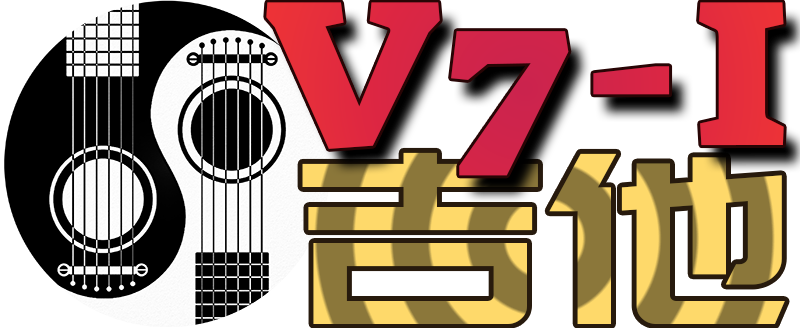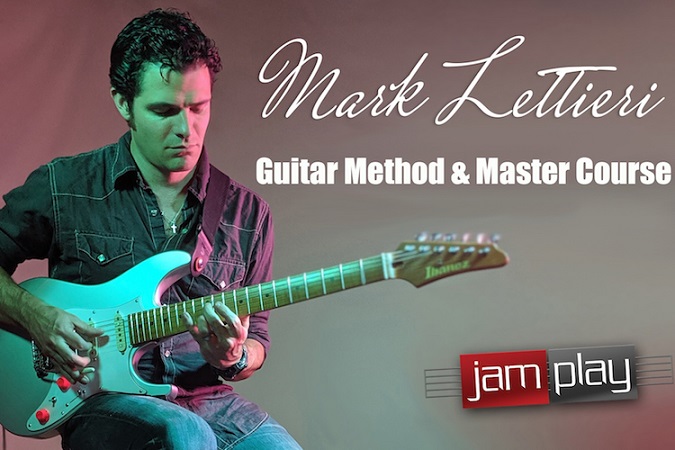讲解时长6小时,练习时长3小时30分钟。更多预览
Lesson 1: Guitar Method with Mark Lettieri
Grammy award winner Mark Lettieri brings his jazz fusion and session chops to JamPlay in what he calls Mark Lettieri's guitar method. This master course is designed to teach you how Mark thinks, plays and creates. From practical application to conceptual ideas on arranging and composition, Mark breaks down how it is he, does what he does best!
2:36 mins
Lesson 2: The 2 Chord: Simple Shape, Not So Simple Sound
The first module of Mark's lesson series is all about harmony, voicings and progressions. The first lesson in this module is on what Mark calls the "2" chord. More specifically, this is a chord that has a 2nd interval. He demonstrates the shapes and how it can be used harmonically over a backing track.
19:56 mins
Lesson 3: Drawing Pictures: Scales as Chords - Major
Lesson 3 is all about visualizing a scale in a linear fashion, instead of as a box. Mark discusses and demonstrates how to draw chord shapes from scales and you'll apply this technique over a backing track.
18:03 mins
Lesson 4: Drawing Pictures: Scales as Chords - Minor
Lesson 4 picks up where you left off on lesson 3. This time you'll be looking at minor chords.
13:44 mins
Lesson 5: Keep it Tight: Two Note Chords with Purpose
Sometimes when working in an ensemble, those big luscious chords just create mud in the mix. In lesson 5 Mark demonstrates and discusses how to use simple 2 and 3 note chord voicings in order to cut through the mix.
14:22 mins
Lesson 6: Point/Counterpoint
In lesson 6, Mark takes queues from gospel, modern jazz and classical harmony to demonstrate counterpoint and how to use it to navigate a chord progression.
19:25 mins
Lesson 7: To B or Not to B: Pivoting Shapes off the B String
Using a single string and a single note, it's possible to build different types of progressions with different shapes. In lesson 7, Mark shows you how!
18:02 mins
Lesson 8: Soulful Shapes and Extensions 1
Starting to round out this first module, Mark takes a look at soulful sounding triad shapes that can be used with R&B and Pop recordings.
15:05 mins
Lesson 9: Soulful Shapes and Extensions 2
Lesson 9 expands on the concepts taught in the previous lesson.
14:52 mins
Lesson 10: Muting and Ghost-Notes
Lesson 10 starts the second module of this course. Called "Groove, Rhythm, Technique and Time-Feel" this module covers everything about grooving and rhythms. To start off, Mark talks about ghosted notes that you feel more than you hear.
20:41 mins
Lesson 11: One at a Time: Single Note Groove
In lesson 11, it's time to start thinking about the tick-tack or stick rhythm. There are various names to this technique, but Mark breaks it down here to help with a funk groove.
22:10 mins
Lesson 12: Up for the Downstroke: Clavinet Picking
Lesson 12 is all about super short staccato notes. So short in fact that they sometimes feel and sound like a clavinet.
15:42 mins
Lesson 13: Off the One: 16ths and Displacement
In lesson 13, Mark discusses and demonstrates displacing notes by a sixteenth. This is an often used rhythmic trick that helps create push and pull in a song or tune.
16:41 mins
Lesson 14: Thumb Bass Style
In lesson 14 Mark debuts a thumb and fingerstyle technique used to create some separation in the bass and chords or melody.
16:59 mins
Lesson 15: Hybrid Pick'd Comping
Similar to the thumb bass style previously learned, this lesson is all about the country flare of Hybrid Picking.
16:11 mins
Lesson 16: Feel Shifting and Swing
Music doesn't always correlate directly with it's many parts. Often you may shift styles and feels over various parts of a song. In this lesson Mark discusses playing swung over a straight feel and also starts to talk about displacing rhythms.
18:45 mins
Lesson 17: The Sample: Muted Chords and HipHop Rakes
Playing off some of the techniques already discussed, Mark breaks down a technique where you can get an R&B "sample" type sound from the guitar. This will be useful when playing anything with a soul or modern R&B vibe.
18:10 mins
Lesson 18: Groove Formulas 1: Riffs with Chordal Punctuation
Lesson 18 starts the next module in this course. This module covers groove construction, part arranging and composition ideas. To start off with, Mark introduces the idea of punctuation and grammar to music.
15:58 mins
Lesson 19: Groove Formulas 2: Chords with Riff Punctuation
In lesson 19, Mark reverses the ideas from the previous lesson. You'll be thinking about riff vocabulary from a different angle.
14:56 mins
Lesson 20: Stacking Chord Shapes 1: Groove Shapes
Lesson 20 is all about double tracking. Specifically tracking stereo guitar parts that are similar or identical.
24:45 mins
Lesson 21: Stacking Chord Shapes 2: Ambient/Textural Shapes
Lesson 21 continues with the same ideas discussed in lesson 20. This time mark discusses making more ambient and textural sounds instead of basic double tracking.
17:10 mins
Lesson 22: Chord Splitting
We're still working in the double track universe in lesson 22. In this lesson Mark discusses taking a large chord and breaking its sonic parts into two, which are then played by different guitars.
18:05 mins 3.0
Lesson 23: Adding Melodies to Chords
In lesson 23, Mark discusses composition when you have a starting foundation based off of a chord progression.
15:10 mins
Lesson 24: Adding Chords to Melodies
Lesson 24 is the reverse of lesson 23. Mark discusses how to add chords and progressions to your composition if you already have a melody.
17:41 mins
Lesson 25: Creating Chord Progressions with the Interval System
What if you are trying to compose, but you don't have...anything at all? Mark discusses and demonstrates a handy way of creating a chord progression by using a single note and using varying intervals.
14:30 mins
Lesson 26: Singing and Rapping
Lesson 26 starts the next module in Mark Lettieri's course. This one titled "Soloing, Improvisation and Specialized Techniques" will guide you through aspects of creating meaningful solos as well as concepts and techniques to spice up your playing. Lesson 26 is all about making the guitar sing, or rap.
18:29 mins
Lesson 27: Grammatical Soloing: Chord Punctuation in Lead Lines
Solos don't always have to be about single note lines. In lesson 27 Mark discusses the aspect of chord punctuation to add harmony to your solos.
18:22 mins
Lesson 28: Linear Two Note Groupings
Mark helps you "get outside the box" by exploring linear scales up and down the neck. By using two adjacent strings, you can create some interesting intervalic chord groupings to add to your playing.
20:30 mins
Lesson 29: Out Stuff: The Funky Flat 5
Lesson 29 is all about getting funky with chromaticism. Mark discusses the use of the flatted five in blues and rock phrasing and how it interacts with tonality.
18:07 mins
Lesson 30: Out Stuff: Altered Scale Dominant and Minor Blues
In lesson 30 Mark explores the half-whole diminished scale, commonly referred to as the "altered scale." He discusses and demonstrates how he uses it to color his playing.
18:49 mins
Lesson 31: The Blur: Bend/Slur Hybrid Technique
In lesson 31 mark introduces a bend and slur technique that he uses to give a bit more spice to a simple bent note by adding a slide effect.
16:11 mins
Lesson 32: The Pitch Bend: Micro-bends for Chromaticism
Lesson 32 is all about emulating the pitch bend effect commonly used by keyboard players. Mark discusses the technique and demonstrates it's uses.
19:34 mins
Lesson 33: Groovy Legato Pivoting
To close out his series, Mark offers up his take on legato playing that uses a barred finger to allow additional hammer-ons and pull-offs on adjacent strings.
18:35 mins
1.如果遇到其他问题可到问答社区进行提问!“进入问答社区”
2.本站非常重视知识产权,如有侵犯任何第三方权益,请及时联系我们,将及时予与删除!“版权协议点此了解”!


 x
x